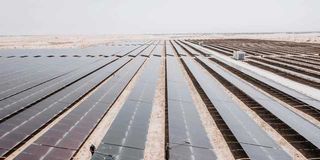Decentralised solar power mini-grids a safer option

A solar power plant in Mauritania. Mini-grids can help avoid the risks and costs of long-distance transmission while providing reliable and affordable electricity to communities that are not connected to the national grid or face frequent power outages.
Modern warfare has brought with it sophisticated siege systems. With increasingly digitised energy systems, therein lies the danger of having a centralised energy infrastructure.
In Kenya, we have had countrywide power outages as a result of either internal or external sabotage. A recent power blackout was explained euphemistically as a‘ system disturbance’.
The cyberattack on the energy grid of Ukraine by hackers believed to be linked to Russia highlighted the vulnerability of centralised power systems to disruptions and sabotage.
Most of Ukraine’s power supply relies on large central power plants and transmission lines, which are easier targets for cyberattacks or physical attacks than decentralised grids that use renewable energy sources.
As more countries and communities seek to increase their energy security and reduce their carbon footprint, one option that is gaining traction is decentralised solar power mini-grids.
A decentralised solar power mini-grid consists of small-scale solar panels that are installed on rooftops or on the ground, connected to a battery storage system and a smart metering system.
These mini-grids can be managed locally and independently, without relying on a central power plant or a national grid.
Mini-grids can help avoid the risks and costs of long-distance transmission while providing reliable and affordable electricity to communities that are not connected to the national grid or face frequent power outages.
Decentralised solar power mini-grids are also resilient to cyberattacks and other forms of disruption. Besides, mini-grids are designed to operate even if some panels or batteries fail or are damaged.
In the case of Ukraine, the attack on the central power system caused blackouts in several regions and disrupted critical services such as water supply and heating, affecting millions of people and mirroring what happened in a peaceful Kenya; with outages affecting Kisumu, Eldoret and Nakuru.
New technologies
Mini-grids can be tailored to the needs and resources of specific communities or businesses and can be expanded or modified as demand grows or new technologies become available.
The cost of setting up mini-grids has always been cited as a disincentive. This, coupled with regulatory barriers and limited access to financing, has been the blight for most African countries.
But this is changing. The World Bank and the Nigerian Rural Electrification Agency are using Odyssey an American EPCFM (Engineering, Procurement, Construction and Financing and Management) to implement big data solutions for one of Nigeria’s most ambitious off-grid rural electrification programmes in history worth about Sh46 billion.
Kenya has already adopted ambitious targets for mini-grid deployment and has implemented supportive policies, such as feed-in tariffs and tax exemptions, but more needs to be done at the execution level.
Ms Hassan is Business Development Manager, SolarNow Services (EA) [email protected]





